 | ||
During the Enlightenment and the industrial revolution, Scottish industrial policy was made by the Board of Trustees for Fisheries, Manufactures and Improvements in Scotland, which sought to build an economy complementary, not competitive, with England. Since England had woollens, this meant linen.
Contents
The Board was established in 1727, with the purpose of dispersing grants to encourage the growth of the fishing and manufacturing industries.
When state regulation of the linen industry was abolished in 1823, the focus of the board turned to the decorative arts and the improvement of fine arts education. The Board had established the Trustees Drawing Academy of Edinburgh in 1760, to improve industrial design, and in 1906 the Board's remaining functions were transferred to the Trustees of the National Galleries of Scotland by the National Galleries of Scotland Act.
Linen industry
The linen industry was Scotland's premier industry in the 18th century and formed the basis for the later cotton, jute, and woollen industries.
Encouraged and subsidized by the Board of Trustees so it could compete with German products, merchant entrepreneurs became dominant in all stages of linen manufacturing and built up the market share of Scottish linens, especially in the American colonial market. The British Linen Company, established in 1746, was the largest firm in the Scottish linen industry in the 18th century, exporting linen to England and America. As a joint-stock company, it had the right to raise funds through the issue of promissory notes or bonds. With its bonds functioning as bank notes, the company gradually moved into the business of lending and discounting to other linen manufacturers, and in the early 1770s banking became its main activity. Renamed the British Linen Bank in 1906, it was one of Scotland's premier banks until it was bought out by the Bank of Scotland in 1969. It joined the established Scottish banks such as the Bank of Scotland (Edinburgh, 1695) and the Royal Bank of Scotland (Edinburgh, 1727). Glasgow would soon follow and Scotland had a flourishing financial system by the end of the century. There were over 400 branches, amounting to one office per 7000 people, double the level in England. The banks were more lightly regulated than those in England. Historians often emphasise that the flexibility and dynamism of the Scottish banking system contributed significantly to the rapid development of the economy in the 19th century.
